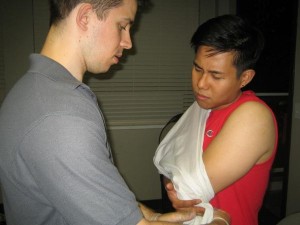When one sustains a wound, especially major ones, it is necessary to learn how to properly change dressings. Changing dressings is essential to avoid infections from occurring. Moreover, by placing a fresh dressing on a wound and allowing it to dry, there is wound drainage and dead tissue can also be removed. The doctor or nurse would usually advise the patient on the best type of dressing to be used for the type of wound and how often the dressing should be changed. There is less need to change gauze as the wound heals.
There are three steps in to properly changing the dress: removing the old dressing, cleaning the wound and putting the new dressing. It is generally advised to use a different pair of non-sterile gloves before beginning a new step. Aside from three pairs of non-sterile gloves, materials needed include: gauze pads, dressing pad, saline solution, packing tape, clean washcloth, clean towel, plastic bag, warm water, and soap
How to Change Dressings: Removing the Old Dressing
The first step on changing dressings is removing the old dressing. Before removing the old dressing, it is recommended to thoroughly wash hands with warm water and soap and to put on a pair of non-sterile gloves.
- Carefully remove the tape.
- Take out the old dressing. If it is sticking to the skin, wet warm water. This will loosen the dressing.
- Take out the gauze pads or packing tape from inside the wound.
- Place all used material (old dressing, packing material, used gloves) in a plastic bag and set aside.
How to Change Dressings: Cleaning the Wound
To properly change dressings, it is also necessary to clean the wound before placing a new dressing. The steps to cleaning a wound is as follows:
- Wear a new pair of non-sterile gloves.
- Gently clean the wound with warm water and soap using a clean, soft washcloth. There should be minimal bleeding.
- Rinse the wound water with water. Do not rub it dry, instead pat dry gently with a clean towel.
- Observe for increased redness, swelling, or bad odour.
- Check the colour and amount of drainage from the wound.
- After cleaning the wound, dispose the gloves in the plastic bag.
How to Change Dressings: Putting the New Dressing
The last step to changing the dressing is putting the new dressing.

Ensure that one washes their hand before wearing a new pair of non-sterile gloves.
- Pour saline into a clean bowl. Place all the gauze pads and any packing tape that will be used in the bowl.
- Squeeze the saline from the gauze pads or packing tape until there are no more drops.
- Place the gauze pads or packing tape on the wound. Fill in the wound and any spaces under the skin. The wet gauze or packing tape should not come into contact with the healed skin.
- Cover the gauze or packing tape with a large dry dressing. Using a rolled gauze or tape, hold the dressing place.
- Put all the used materials in the plastic bag. Securely close the plastic bag. It may be put inside a second plastic bag and closed again securely. Throw in the trash can.
- Thoroughly wash hands after finishing.
Disclaimer: The information from this article does not provide medical advice and should not be substituted for formal training. Seek medical attention when necessary. To learn more about to change dressings and other essential techniques in first aid, enrol in First Aid Courses and CPR Courses with workplace approved Training.
Online Sources:
http://www.nlm.nih.gov/medlineplus/ency/patientinstructions/000315.htm
